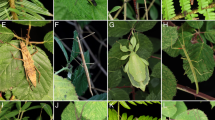Abstract
Defense glands were examined in the adults of 65 species belonging to 10 different subfamilies. They were found in the pronota and elytra of members of the subfamilies Criocerinae, Chrysomelinae, Galerucinae, and Alticinae. It is suggested that these glands appeared monophyletically in the course of evolution and that the absence of glands in several species of the two most evolved subfamilies is a secondary event, explained by the presence of alternative efficient defensive behaviors: reflex bleeding in the Galerucinae and escape mechanism of jumping in the flea beetles. It is also suggested that a large distribution of the glands at the surface of the beetles is a primitive condition and that in the course of evolution only the glands most efficiently located along the edges of the pronotum and elytra were maintained. Such evolution has occurred several times. Alternative and complementary defensive mechanisms are also listed and discussed.
Similar content being viewed by others
References
Balsbaugh, E. 1967. Possible mimicry between certain Carabidae and Chrysomelidae.Coleopt. Bull 21:199–140.
Capinera, J.L. 1976. Asparagus beetle defense behavior adaptations for survival in dispersing and non-dispersing species.Ann. Entomol. Soc. Am. 69:269–272.
Cuenot, L. 1896. Sur la saignée refléxe et les moyens de défense de quelques insectes.Arch. Zool. Exp. Gen. 4:665–680.
Daloze, D., andPasteels, J.M. 1979. Production of cardiac glycosides by chrysomelid beetles and larvae.J. Chem. Ecol. 5:63–77.
Derenne, E. 1963. Catalogue des coléoptères de Belgique: Chrysomeloidae, Chrysomelidae.Bull. Ann. Soc. R. Entomol. Belg. 94:1–104.
Deroe, C., andPasteels, J.M. 1977. Defensive mechanisms against predation in the Colorado beetle (Leptinotarsa decemlineata Say).Arch. Biol. 88:289–304.
Eisner, T. 1972. Chemical ecology: On arthropods and how they live as chemists.Verh. Dsch. Ges. 65:123–136.
Hollande, A.Ch. 1909. Sur la fonction d'excrétion chez les insectes salicicoles et en particulier sur l'existence de dérivés salicylés.Ann. Univ. Grenoble 21:459–517.
Hollande, A.Ch. 1911. L'autohémorrhée ou le rejet du sang chez les insectes.Arch. Anat. Microsc. 13:171–318.
Hollande, A.Ch. 1926. La signification de l'autohémorrhée chez les insectes.Arch. Anat. Microsc. 22:374–412.
Jolivet, P. 1946. Quelques remarques sur l'autohémorrhée chez lesTimarcha (Col. Chrysomelidae).Misc. Entomol. 43:29–30.
Jolivet, P. 1948. Contribution à l'étude des Americanotimarcha n. subg. (Col. Chrys.).Bull. Mus. R. Hist. Natl. Belg. 43:1–11.
Jolivet, P. 1967. Les alticides venimeux de l'Afrique du Sud.L'Entomologiste 23:100–111.
Jolivet, P. 1978. Sélection trophiques chez les Clytrinae, Cryptocephalinae et Chlamisinae (Comptosoma) et les Lamprosomatidae (Cyclica) (Colèoptera Chrysomelidae).Acta Zool. Pathol. Antwerp 70:167–200.
Jolivet, P., andPetitipierre, E. 1976. Sélection trophique et évolution chromosomique chez les Chrysomelinae (Col. Chrys.).Acta Zool. Pathol. Antwerp 66:69–90.
Jones, F.M. 1932. Insect coloration and the relative acceptability of insects to birds.Trans. R. Entomol. Soc. London 80:345–385.
Lindroth, C.H. 1971. Disappearance as a protective factor. A supposed case of Batesian mimicry among beetles (Coleoptera; Carabidae and Chrysomelidae).Entomol. Scand. 2:41–48.
Patay, R. 1937. Quelques observations anatomiques et physiologiques sur le Doryphore.Bull. Soc. Sci. Bretagne 14:94–102.
Pasteels, J.M., andDaloze, D. 1977. Cardiac glycosides in the defensive secretion of chrysomelid beetles: Evidence for their production by the insects.Science 197:70–72.
Pasteels, J.M., Daloze, D., Van Dorsser, W., andRoba, J. 1979. Cardiac glycosides in the defensive secretion ofChrysolina herbacea (Coleoptera, Chrysomelidae). Identification, biological role and pharmacological activity.Comp. Biochem. Physiol. 63C:117–121.
Tower, W.L. 1906. An investigation of evolution in chrysomelid beetles of the genusLeptinotarsa.Carnegie Inst. Washington Publ. 42:1–320.
Author information
Authors and Affiliations
Rights and permissions
About this article
Cite this article
Deroe, C., Pasteels, J.M. Distribution of adult defense glands in chrysomelids (Coleoptera: Chrysomelidae) and its significance in the evolution of defense mechanisms within the family. J Chem Ecol 8, 67–82 (1982). https://doi.org/10.1007/BF00984006
Received:
Revised:
Issue Date:
DOI: https://doi.org/10.1007/BF00984006




